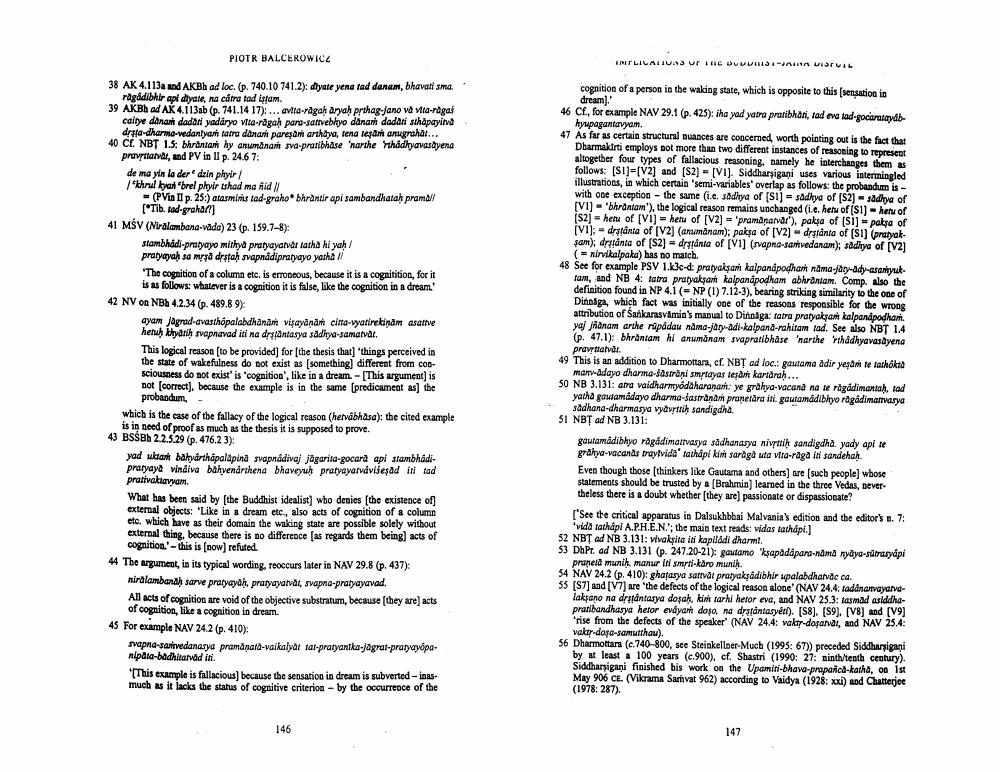________________
PIOTR BALCEROWICZ
38 AK 4.113a and AKBh ad loc. (p. 740.10 741.2): diyate yena tad danam, bhavati sma ragadibhir api diyate, na câtra tad istam.
39 AKBh ad AK 4.113ab (p. 741.14 17):...avita-ragaḥ aryaḥ prthag-jano và vita-ragaś caitye danam dadari yadaryo vita-ragaḥ para-sativebhyo danam dadati sthāpayitva dra-dharma-vedantyam tatra danam paresăm arthaya, tena teşam anugrahai... 40 Cf. NBT 1.5: bhräntam hy anumanam sva-pratibhase 'narthe thadhyavasayena pravṛttavat, and PV in II p. 24.67:
de ma yin la der dzin phyir
/khrul kyan "brel phyir ishad ma ñid
= (PVin II p. 25:) atasmims tad-graho bhrantir api sambandhataḥ prama!! [*Tib. tad-graha??]
41 MSV (Niralambana-vada) 23 (p. 159.7-8):
stambhadi-pratyayo mithya pratyayatvar tatha hi yaḥ
pratyayaḥ sa mrsa drstah svapnådipratyayo yatha !!
The cognition of a column etc. is erroneous, because it is a cognitition, for it is as follows: whatever is a cognition it is false, like the cognition in a dream."
42 NV on NBh 4.2.34 (p. 489.89):
ayam jagrad-avasthapalabdhānām visayaṇām cinta-vyatirekiņām asative hetuḥ khyariḥ svapnavad iti na dräntasya sadhya-samavät.
This logical reason [to be provided] for [the thesis that] 'things perceived in the state of wakefulness do not exist as [something] different from consciousness do not exist' is 'cognition', like in a dream. - [This argument] is not [correct], because the example is in the same [predicament as] the probandum,
which is the case of the fallacy of the logical reason (hervabhasa): the cited example is in need of proof as much as the thesis it is supposed to prove.
43 BSSBh 2.2.5.29 (p. 476.2 3):
yad uktam bahyarthapaläpinä svapnádivaj jägarita-gocarà api stambhádipratyaya vindiva bähyendrthena bhaveyuh pratyayarvávišesad iti tad prativaktavyam.
What has been said by [the Buddhist idealist] who denies [the existence of] external objects: 'Like in a dream etc., also acts of cognition of a column etc. which have as their domain the waking state are possible solely without external thing, because there is no difference [as regards them being] acts of cognition."- this is [now] refuted.
44 The argument, in its typical wording, reoccurs later in NAV 29.8 (p. 437): niralambanah sarve pratyayaḥ, pratyayatvät, svapna-pratyayavad.
All acts of cognition are void of the objective substratum, because [they are] acts of cognition, like a cognition in dream.
45 For example NAV 24.2 (p. 410):
svapna-sanvedanasya pramäṇata-vaikalyat tat-pratyanika-jagrat-pratyayopanipata-badhitatvaditi.
[This example is fallacious] because the sensation in dream is subverted-inasmuch as it lacks the status of cognitive criterion - by the occurrence of the
146
IMPLICATIONS OF THE BUDDHIST varVIL
cognition of a person in the waking state, which is opposite to this [sensation in dream].'
46 Cf., for example NAV 29.1 (p. 425): iha yad yatra pratibhati, tad eva tad-gocarataydbkyupagantavyam.
47 As far as certain structural nuances are concerned, worth pointing out is the fact that Dharmakirti employs not more than two different instances of reasoning to represent altogether four types of fallacious reasoning, namely he interchanges them as follows: [S1]-[V2] and [S2] [VI]. Siddharsigani uses various intermingled illustrations, in which certain 'semi-variables' overlap as follows: the probandum iswith one exception the same (i.e. sadhya of [S1] sadhya of [S2] sadhya of [VI] 'bhraniam'), the logical reason remains unchanged (i.e. heru of [S1]-hetu of [S2]henu of [V1] hetu of [V2]='pramanarvar"), paksa of [SI]= paksa of [VI]: dratanta of [V2] (anumanam); paksa of [V2] drstanta of [S1] (pratyaksam); dritânia of [S2] dritánia of [V1] (svapna-samvedanam); sadhya of [V2] (= nirvikalpaka) has no match.
48 See for example PSV 1.k3c-d: pratyakşamṁ kalpanapodhamṁ nama-jary-ady-asamyuktam, and NB 4: tatra pratyakşam kalpanapodham abhraniam. Comp. also the definition found in NP 4.1 (= NP (1) 7.12-3), bearing striking similarity to the one of Dinnaga, which fact was initially one of the reasons responsible for the wrong attribution of Sankarasvamin's manual to Dinnaga: tatra pratyakşam kalpanapodham. yaj jñanam arthe rapádau nama-jary-adi-kalpana-rahitam tad. See also NBT 1.4 (p. 47.1): bhräntam hi anumanam svapratibhase 'narthe 'rthâdhyavasayena
pravṛttatvar.
49 This is an addition to Dharmottara, cf. NBT ad loc.: gautama adir yeşām te tathoki man-adayo dharma-sastrani smṛtayas teşām kartāraḥ...
50 NB 3.131: arra vaidharmyödäharaṇam: ye grahya-vacana na te ragadimantaḥ, tad yatha gautamadayo dharma-sastranam pranetära iti gautamadibhyo ragadimativasya sadhana-dharmasya vyavṛttiḥ sandigdha.
51 NBT ad NB 3.131:
gautamadibhyo ragadimattvasya sadhanasya nivṛttiḥ sandigdha. yady api te grahya-vacanas traytida tathapi kim saraga uta vita-raga iti sandehaḥ
Even though those [thinkers like Gautama and others] are [such people] whose statements should be trusted by a [Brahmin] learned in the three Vedas, nevertheless there is a doubt whether [they are) passionate or dispassionate?
["See the critical apparatus in Dalsukhbbai Malvania's edition and the editor's n. 7: 'vida tathapi A.P.H.E.N.'; the main text reads: vidas tathapi.]
52 NBT ad NB 3.131: vivakşita iti kapiladi dharm!.
53 DhPr. ad NB 3.131 (p. 247.20-21): gautamo 'kṣapädäpara-nāmā nyāya-sätrasyāpi praneta muniḥ, manur iti smrti-karo munih.
54 NAV 24.2 (p. 410): ghatasya sattvat pratyakşidibhir upalabdhatvac ca.
55 [S7] and [V7] are "the defects of the logical reason alone' (NAV 24.4: tadânanvayatvalakṣano na drifantasya doşaḥ, kim tarhi hetor eva, and NAV 25.3: tasmad asiddhapratibandhasya hetor evayam doso, na drstäntasyéti). [S8]. [S9], [V8] and [V9] 'rise from the defects of the speaker' (NAV 24.4: vakt-dosarvai, and NAV 25.4: vakt-doga-samutthau).
56 Dharmottara (c.740-800, see Steinkellner-Much (1995: 67)) preceded Siddharsigani by at least a 100 years (c.900), cf. Shastri (1990: 27: ninth/tenth century). Siddharsigani finished his work on the Upamiti-bhava-prapañca-katha, on 1st May 906 CE. (Vikrama Sarivat 962) according to Vaidya (1928: xxi) and Chatterjee (1978: 287).
147




